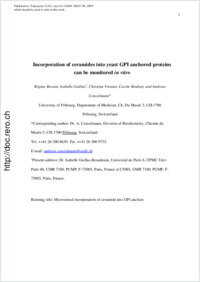Incorporation of ceramides into yeast glycosylphosphatidylinositol-anchored proteins can be monitored in vitro
- Bosson, Régine Department of Medicine, University of Fribourg, Switzerland
- Guillas, Isabelle Department of Medicine, University of Fribourg, Switzerland
- Vionnet, Christine Department of Medicine, University of Fribourg, Switzerland
- Roubaty, Carole Department of Medicine, University of Fribourg, Switzerland
- Conzelmann, Andreas Department of Medicine, University of Fribourg, Switzerland
-
12.12.2008
Published in:
- Eukaryotic Cell. - 2009, vol. 8, no. 3, p. 306-314
English
After glycosylphosphatidylinositols (GPIs) are added to GPI proteins of Saccharomyces cerevisiae, a fatty acid of the diacylglycerol moiety is exchanged for a C26:0 fatty acid through the subsequent actions of Per1 and Gup1. In most GPI anchors the thus modified diacylglycerol-based anchor is subsequently transformed into a ceramide-containing anchor, a reaction, which requires Cwh43. Here we show that the last step of this GPI anchor lipid remodeling can be monitored in microsomes. The assay uses microsomes from cells having been grown in the presence of myriocin, a compound that blocks the biosynthesis of dihydrosphingosine (DHS) and thus inhibits the biosynthesis of ceramide based anchors. Such microsomes, when incubated with [³H]DHS, generate radiolabeled, ceramide-containing anchor lipids of the same structure as made by intact cells. Microsomes from cwh43Δ or mcd4Δ mutants, unable to make ceramide-based anchors in vivo, do not incorporate [³H]DHS into anchors in vitro. Moreover, gup1Δ microsomes incorporate [³H]DHS into the same abnormal anchor lipids as gup1Δ cells synthesize in vivo. Thus, the in vitro assay of ceramide incorporation into GPI anchors faithfully reproduces the events that occur in mutant cells. Incorporation of [³H]DHS into GPI proteins is observed with microsomes alone, but the reaction is stimulated by cytosol or bovine serum albumin, ATP plus coenzyme A or C26:0-Coenzyme A, particularly if microsomes are depleted of acyl-CoA. Thus, [³H]DHS cannot be incorporated into proteins in the absence of acyl-CoA.
- Faculty
- Faculté des sciences et de médecine
- Department
- Département de Biologie
- Language
-
- English
- Classification
- Biological sciences
- License
- License undefined
- Identifiers
-
- RERO DOC 11308
- DOI 10.1128/EC.00257-08
- Persistent URL
- https://folia.unifr.ch/unifr/documents/300905
Statistics
Document views: 67
File downloads:
- bosson_ici.pdf: 105
